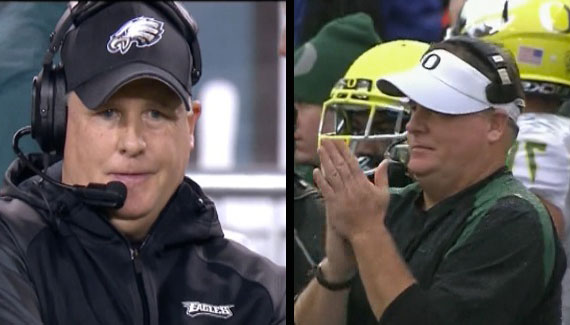It has been almost a decade that I have been the wide receivers coach at Villanova, and during this time I have been fortunate to be a part of a great spread offensive system and also watch the evolution of offensive football up close. As you already may know, my biggest influence during this time has been the Chip Kelly offense — starting with his time in our league at New Hampshire and reaching obsessive levels on my part during Kelly’s years in Eugene. Both the scheme and style of those Oregon teams has been critical in the development of my own offensive philosophy and identity.
An integral part of the Oregon offense during this time has been the packaging of the Zone Read with quick screens. I have written about the value of the bubble constraint and how Oregon has used it to create a dominant running game. The zone read bubble has stretched defenses from sideline to sideline and created huge interior running lanes for the Ducks’ record-setting rushing attack.
During my research of the Eagles’ offense in 2013, I found both the zone read and bubble as staples of the Oregon-style running game constructed by Kelly. Also discovered was the next step in the evolution of the Chip Kelly offense – to the combination of the zone read run game with down field passes to tight ends and wide receivers within the same play call.
These “packaged run/pass plays” (with the ability to end up as either a run or pass based on the defensive look), were already on the rise in college football. In the NFL, these packaged plays help Kelly attack defenses in a way that was both similar to his Oregon days and new to the defenses he faced. This article will analyze the development of run/pass plays with the Eagles this season and show how Chip packaged his staple plays into explosive ones.
(FishDuck note: Examine these plays and see if you can recall Oregon doing them, and if not — this could be the future path of the Oregon Spread Offense!)
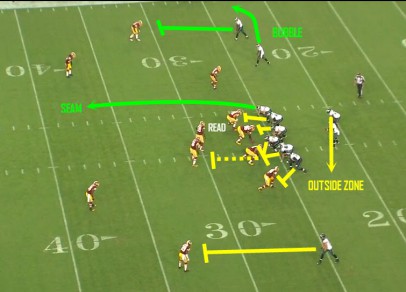
On the second play of the 2013 season (above), Kelly fired a warning shot over the collective heads of the NFL. His spread-to-run offense had expanded in the off season. The first packaged play in Eagles’ history started with a 3×1 formation against the Redskins 4-3 defense. To the tight end side the Eagles are running a Seam-Bubble pass combination (in green).
The offensive line, running back and receiver into the boundary are running the outside zone read (in yellow) away from the tight end. Versus a man coverage or pressure look, where quarterback Mike Vick has the option of handing the ball off to tailback LeSean McCoy. Versus a zone or base defense look, Vick will read the Mike/middle linebacker as his key for where to go with the football.
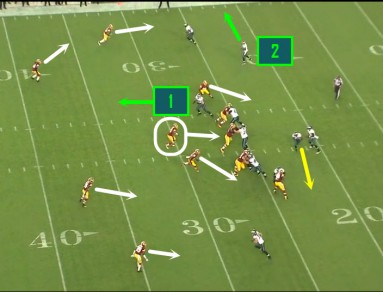
With the Redskins in a two-high safety look, Vick is going to work the Bubble-Seam combination and read linebacker London Fletcher (white circle above). Even in the season opener, Kelly’s “run-first” reputation at Oregon already has the attention of the Washington defense. The boundary safety widens with the outside zone action. The field safety widens with the bubble threat from the No. 2 receiver.
Inside the box, Fletcher’s eyes immediately go to McCoy. When Fletcher reacts downhill, Vick quickly goes to the first read in the progression: tight end Brent Celek running the seam route. When all three linebackers attack the outside zone, Celek gets a free release into the Redskins secondary.
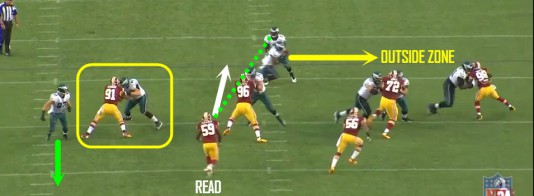
One difference between this particular packaged run/pass above and the normal outside zone read, is the block of the backside tackle. With the pass option added to the play, the Eagles keep the backside tackle locked on to the backside defensive end (yellow box). This drive block by the tackle keeps the defensive end’s hands down and out of Vick’s passing lane to the tight end.
From this end zone shot you can also see Vick’s eyes on read key Fletcher (59). As soon as Fletcher presses the line of scrimmage to stop the run, Vick delivers the ball to Celek (87).
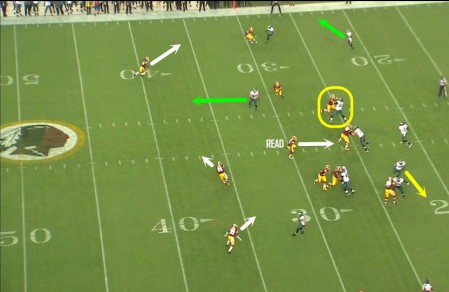
From the wide shot above you can see that shortly after Vick releases the ball, how the outside zone blocking of the Eagles’ offensive line moves the Redskins defense away from the primary receiver (Celek, green arrow). The bubble to the field side moves the two defenders to that side, out of the play. You can also see how the backside tackle’s block (yellow box) opens up the throwing lane to create the Eagles’ first explosive play of the season.
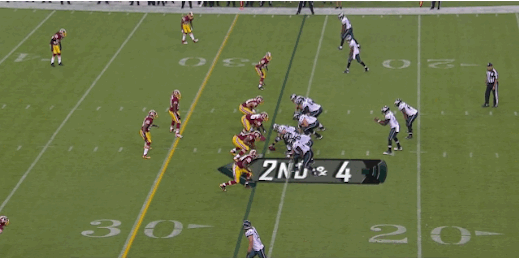

Later in the season, the Eagles used the above variation of this run/pass package to end a snow-filled game against the Lions. One play prior to the 2-minute warning, the Eagles are in full run-out-the-clock/4-minute offense mode. Using as much time as they can, the Eagles line up with 2 tight ends, 2 wide receivers and 1 running back, and call an inside zone read to the left.
What at first appears to be a slight change in the read-blocking of tight end Celek, who now is out on the defensive end and reading the Will linebacker (green arrow) – and is actually the beginning of another run play packaged with a downfield pass.
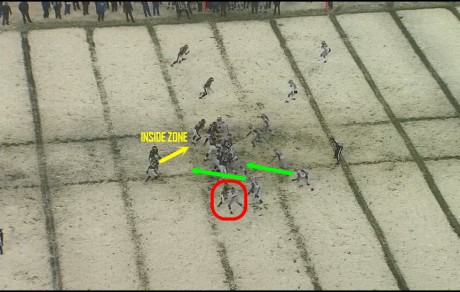
When the ball is snapped (above), the Eagles’ offensive line zone blocks to the left. Celek blocks the defensive end over him, to the right. This scheme leaves both the Will linebacker and safety (green arrows) away from the zone side unblocked.
The time and score of the game (Eagles ahead, 2-minute warning approaching, Lions out of time outs) has the Lions defense keyed into stopping the run. Both safeties are lined up tight to the line of scrimmage. As the tailback enters the mesh with quarterback Foles, covering down Celek (red circle above) is the last thing anyone on the field for Detroit is worried about.

The above end zone shot of this play shows the added value of a packaged play when compared to traditional play action. Rather than fake a run with just the back and the quarterback, packaged plays move defenders by giving the offensive line actual run-blocking responsibility. The threat of the run is perceived as real by the defense because it is legitimate.
Had the Lions’ Will linebacker (58) slow-played the inside zone, Foles still has the ability to give the ball to the tailback. The over-reaction of the two free Lion defenders (58 and 27) occurs because all of the Eagles linemen and tight ends (including eventual pass receiver Celek (red box), are blocking a defender when the running back-quarterback mesh begins.
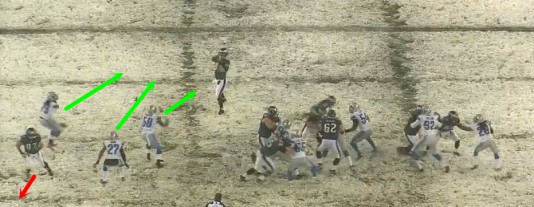
When Foles pulls the ball from the running back, the Eagles’ linemen are still blocking. These linemen are permitted to go downfield 3 yards past the line of scrimmage on pass plays. This allows the Eagles to block aggressively and present a much more authentic run action to the defense. When Celek (red arrow above) releases from his block, both the Eagles’ linemen and the Detroit defenders are still entirely concerned with the inside zone.

From the wide angle view above, you can see the separation created by the run part of the packaged play. The run blocking action of the offensive line is as real as it gets. If the read had been different, Foles would have handed the ball to the tailback. To the offensive line and tailback, this play is nothing more than the standard inside zone read. Only Foles and Celek are running a pass here . . . and that’s exactly what gets Celek open.
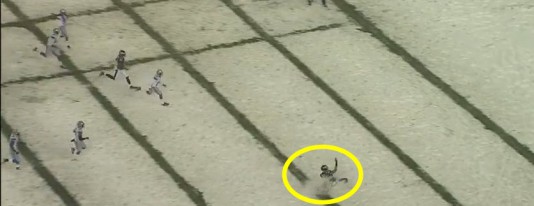
Once Celek has the ball, he shows great situational awareness and does not score the touchdown. The Eagles have already given up both punt and kickoff returns for touchdowns in this game. Rather than score and put the Philadelphia kickoff coverage unit on the field one more time, Celek (yellow circle above) elects to slide inside the Lions 10-yard line. With no time outs and under 2 minutes remaining, Detroit is powerless to stop the clock and the Eagles end the game by taking a knee.
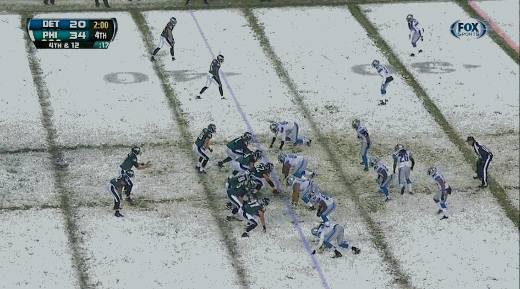
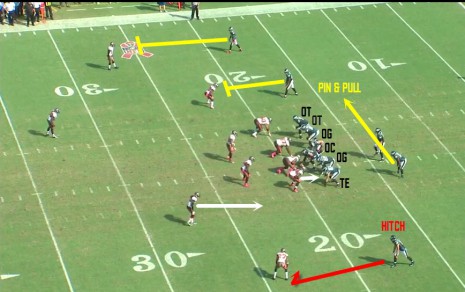
Earlier in the season against Tampa Bay, Kelly shows us above how run/pass packaged plays are evolving to include outside wide receivers. In the 4th quarter vs the Buccaneers, Kelly calls one of his Oregon staple runs (pin & pull outside sweep) out of an unbalance/tackle over formation (black letters) formation. On the backside of the formation Kelly has the single receiver running a quick pass route (hitch – in red). Once again, 9 of the 11 offensive players are executing a run play, with only Foles and the boundary receiver executing a pass.
This package of unbalanced outside run combined with a quick pass on the other side gives Nick Foles the entire width of the field to work with. For the play to succeed, Foles needs to quickly identify how the Bucs adjust to the formation and attack the defense accordingly.
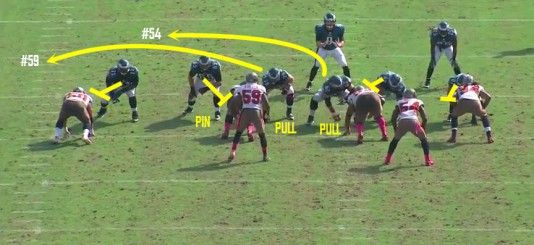
Up front, the Eagles are running the Oregon classic “pin and pull” blocking — one of their favorite plays out of this formation and personnel grouping. Both the play-side guard and center (yellow arrow lines above) are pulling for the two inside linebackers (59 and 54). The backside guard and tight end (lined up as the left tackle in this formation) are responsible for cutting off the backside defensive lineman and keeping them away from the sweep.

After the mesh above, you can see the Tampa defense react to the run element of this packaged run/pass. All six of the Buccaneer interior defenders run hard to the left in an attempt to set an edge against the pin and pull. This defensive pursuit — along with a zone pressure from the Bucs — gives Foles a chance to work the pass part of the package.
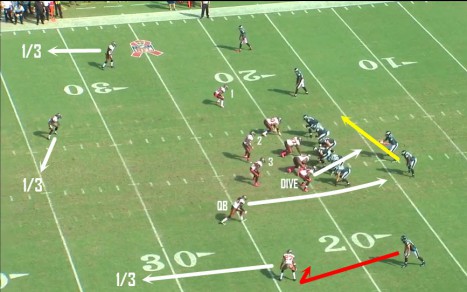
The Bucs have decided to attack this formation with a weak free safety zone blitz. The free safety blitzes the D-gap and the strong safety rotates to centerfield. The 3-deep, 3-under zone coverage behind this blitz has both corners bailing to the deep third. This soft zone is the ideal look for the hitch, built in to the backside of this packaged play. (red line above)

The combination of the zone blitz and defensive pursuit creates open access for the quarterback to the hitch route. The zone pressure (yellow square above) vacates the alley and softens the boundary corner, giving Foles an easy blitz-beating throw. The run/pass package that Kelly has put together gives the quarterback a clear and effective answer to the Bucs’ defensive call. Foles does an excellent job of diagnosing the defense and distributing the football.

This packaged play has also created another critical element of the Chip Kelly offense: skilled players with the ball in open space. Once he has the ball, wide receiver Riley Cooper executes a tight spin toward the outside of the field and away from the two nearest defenders. Combined with the lateral stretch, created by the play’s design, Cooper’s fundamentally sound move with the ball in his hands turns a 5-yard route into a 44-yard gain. Kelly has once again created an explosive play by throwing short and running long.
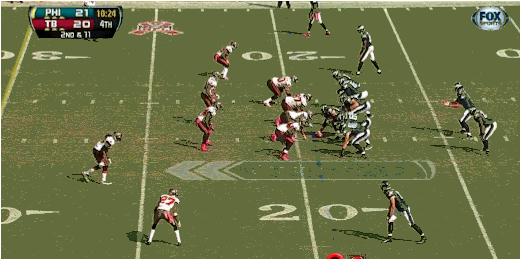
The future of offensive football is the continued expansion of packaged run/pass plays. We are only at the beginning of this trend that combines run blocking with downfield passes. Kelly was at the forefront of packaging runs with quick screens during his years at New Hampshire.
Since then, packaged plays have expanded to include full field and deeper passing concepts. The more that packaged plays develop, the more it appears imagination is the only limit on today’s offensive innovation. Rest assured, much like it was in Eugene, the NFL’s version of Chip Kelly’s offense will be on the cutting edge of whatever is next.
From Philadelphia . . . “Oh how we love to learn about your beloved Ducks — and our Eagles!”
Receivers Coach Brian Flinn
Villanova University
Philadelphia, Pennsylvania
Coach Brian Flinn (Football Analyst) is entering his seventh year as Villanova University’s Wide Receivers Coach and Recruiting Coordinator. A native of Youngstown, OH, Brian Flinn was an All-OAC tight end at Mount Union College before entering the coaching ranks. In addition to Villanova, Coach Flinn has coached at Eastern Illinois University, Drake University, Maryland University, and Mount Union.
Go Villanova Wildcats!

